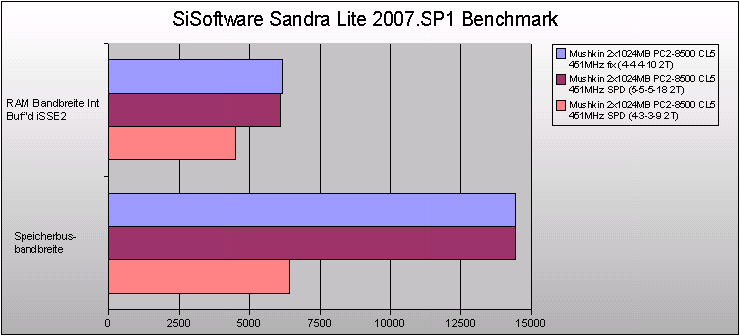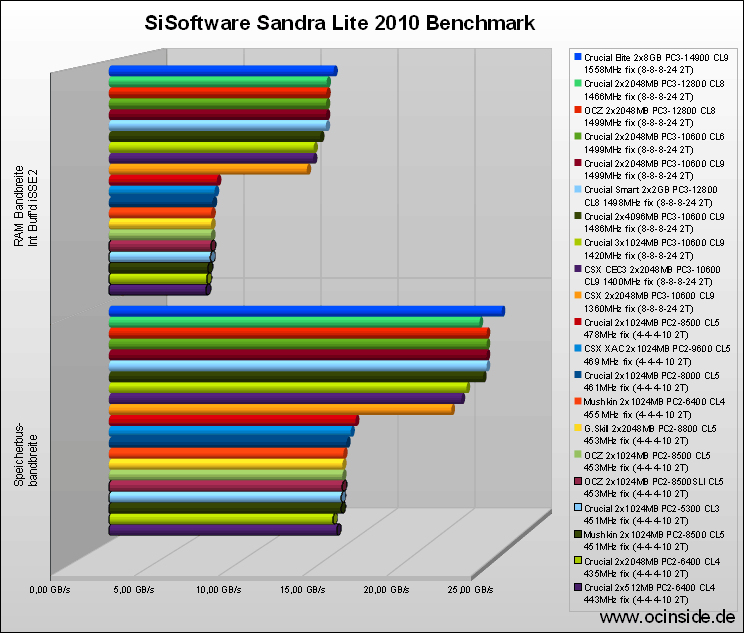
Let us begin with the most important part of the test report, because the optics and packing is of course rather secondary and the highest possible stable performance is the most important factor. CPU on different frequencies depending on the reference clock for the different memory benchmarks. Furthermore the memory modules were tested on another reference board to test the high frequency with higher voltages. The multiplier adjustment remains on 9x with all frequencies, because an adjustment for the CPU in half multiplier steps would be too inaccurate to get nearly the same CPU frequency for all tests.
Microsoft Windows XP Professional SP2 is used as the operating system. The stability was examined with the software Memtest86
and SiSoft Sandra Lite 2007.SP1 program is used for all benchmarks, since it offers extensive adjustments and a fast result comparison.
First the maximum possible frequency of the memory module was determined. The memory frequency was increased in small steps with a fixed memory timing of 4-4-4-10 2T and default memory voltage, as long as the detailed memory test with Memtest86 runs without any errors. This quite long testing time ensured that this frequency works really stable with these modules.
The highest possible frequency with 4-4-4-10 (Tcl Trcd Tras Trp) timings was stable with very high 451 MHz.
It’s possible to run much higher frequencies with increased voltages or lower timings, because the frequency values and timings depends directly from each other. Officially Mushkin specify the voltage of 2.2 – 2.35 V without loosing the warranty and this is a considerable voltage to get nice overclocking results, because the default DDR2 memory voltage is 1.8 Volt. In the test the modules were stable with 2.20 V and timings of 5-5-5-18 up to 600 MHz (DDR2-1200) !!! This isn’t possible on all motherboards, because on the one hand it is necessary that these high clock rates are supported by the motherboard and on the other hand it’s absolutely necessary to support the high memory voltage (Vmem) of 2.2V. For the test I’ve additionally used a slightly modified reference board (Foxconn C51XEM2AA) to get this result.
This highest possible frequency was compared with two settings. On the one hand 451 MHz with SPD values (these are programmed in the SPD IC by the manufacturer), and on the other hand 200 MHz (x2) with SPD values.
By the way, the “Memory Bus Range” is no benchmark value, but this value is quite simple to calculate by the frequency and is useful for the benchmark comparison.
Here’re the benchmark results:
| Frequency | Timing | RAM Range Int Buff’d iSSE2 | Memory bus range |
| 451 MHz | fix (4-4-4-10 2T) | 6152 MB/s | 14432 MB/s |
| 451 MHz | SPD (5-5-5-18 2T) | 6088 MB/s | 14432 MB/s |
| 200 MHz | SPD (4-3-3-9 2T) | 4525 MB/s | 6432 MB/s |
Here’s a diagram of the benchmark values:

Here is a direct benchmark result comparison of some DDR2 and DDR memory modules:

Who expected the Mushkin XP2-8500 at the top of the test results, will be surely surprised, why even a pair of PC2-5300 modules is above the PC2-8500 modules. The test results of the benchmark comparison are based on the standard DDR2 voltage, but the Mushkin modules only gather momentum starting from a voltage of approx. 2.20 V (instead of 1.80 V). So with default Vmem and fast timings it was possible to overclock them up to 451 MHz. With a direct comparison on 2.20 V the overall result would look completely different, because 600 MHz (DDR2-1200 !!!) with 2.20 V is the best result tested at ocinside.de so far.
With the frequency of ~600 MHz the used AMD Athlon 64 3000+ CPU was overclocked up to wonderful 3000 MHz !!! with 9x 333 MHz reference clock and that’s even for an ocinside.de test CPU a fantastic value !

